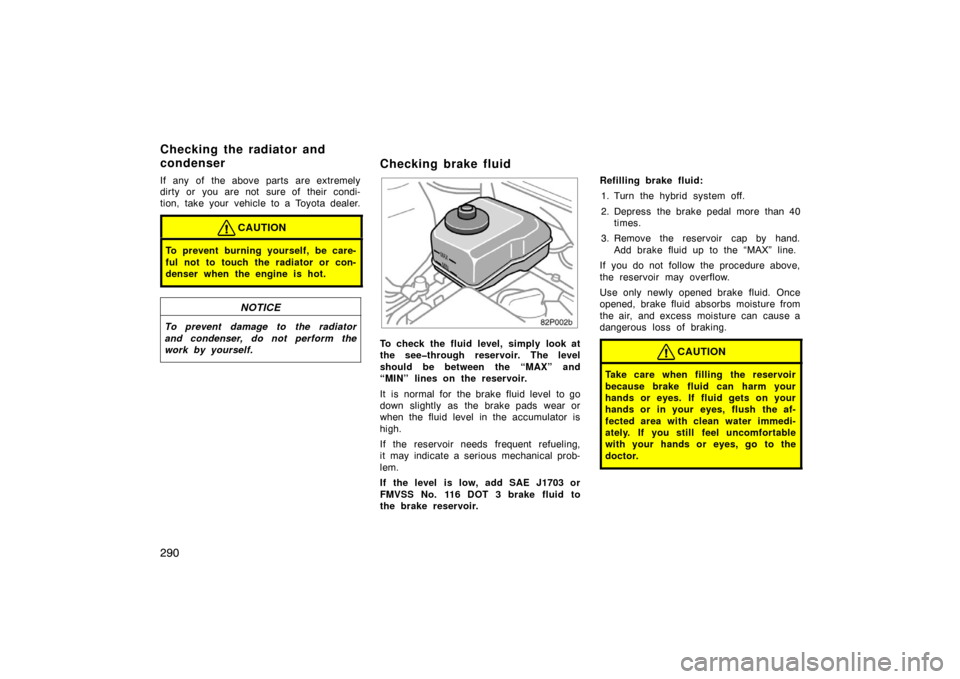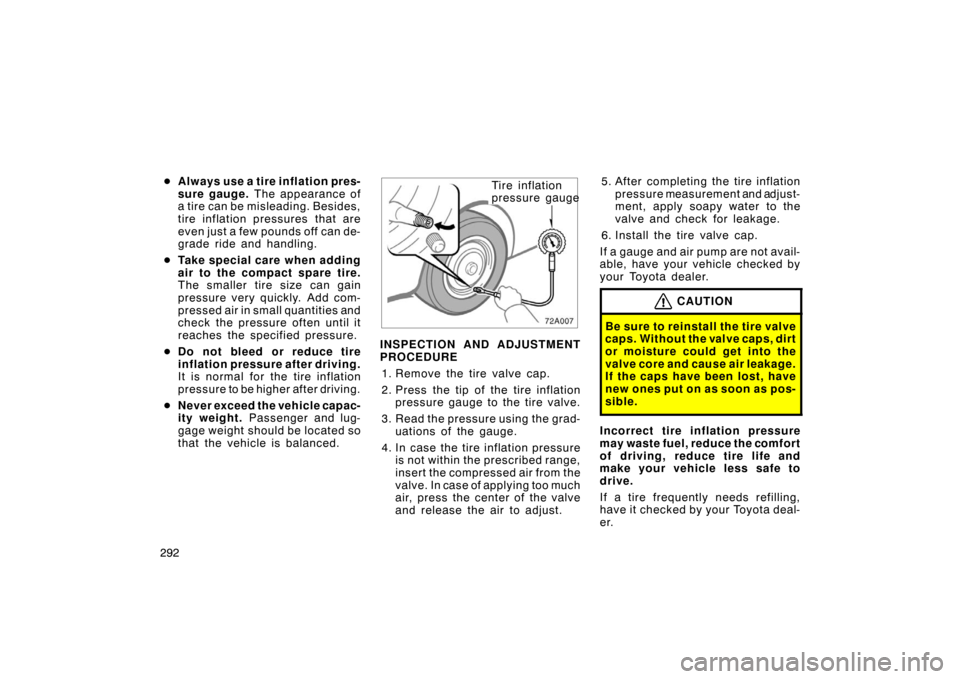Page 290 of 336

290
If any of the above parts are extremely
dirty or you are not sure of their condi-
tion, take your vehicle to a Toyota dealer.
CAUTION
To prevent burning yourself, be care-
ful not to touch the radiator or con-
denser when the engine is hot.
NOTICE
To prevent damage to the radiator
and condenser, do not perform the
work by yourself.
Checking brake fluid
82p002b
To check the fluid level, simply look at
the see�through reservoir. The level
should be between the “MAX” and
“MIN” lines on the reservoir.
It is normal for the brake fluid level to go
down slightly as the brake pads wear or
when the fluid level in the accumulator is
high.
If the reservoir needs frequent refueling,
it may indicate a serious mechanical prob-
lem.
If the level is low, add SAE J1703 or
FMVSS No. 116 DOT 3 brake fluid to
the brake reservoir.Refilling brake fluid:
1. Turn the hybrid system off.
2. Depress the brake pedal more than 40 times.
3. Remove the reservoir cap by hand. Add brake fluid up to the “MAX” line.
If you do not follow the procedure above,
the reservoir may overflow.
Use only newly opened brake fluid. Once
opened, brake fluid absorbs moisture from
the air, and excess moisture can cause a
dangerous loss of braking.CAUTION
Take care when filling the r eservoir
because brake fluid can harm your
hands or eyes. If fluid gets on your
hands or in your eyes, flush the af-
fected area with clean water immedi-
ately. If you still feel uncomfortable
with your hands or eyes, go to the
doctor.
Checking the radiator and
condenser
Page 292 of 336

292�
Always use a tire inflation pres-
sure gauge. The appearance of
a tire can be misleading. Besides,
tire inflation pressures that are
even just a few pounds off can de-
grade ride and handling.
� Take special care when adding
air to the compact spare tire.
The smaller tire size can gain
pressure very qu ickly. Add com-
pressed air in small quantities and
check the pressure often until it
reaches the specified pressure.
� Do not bleed or reduce tire
inflation pressure after driving.
It is normal for the tire inflation
pressure to be higher after driving.
� Never exceed the vehicle capac-
ity weight. Passenger and lug-
gage weight should be located so
that the vehicle is balanced.
Ti r e inf lat ion
pressure gauge
INSPECTION AND ADJUSTMENT
PROCEDURE 1. Remove the tire valve cap.
2. Press the tip of the tire inflation pressure gauge to the tire valve.
3. Read the pressure using the grad- uations of the gauge.
4. In case the tire inflation pressure
is not within the prescribed range,
insert the compressed air from the
valve. In case of applying too much
air, press the center of the valve
and release the air to adjust. 5. After completing the tire inflation
pressure measurement and adjust-
ment, apply soapy water to the
valve and check for leakage.
6. Install the tire valve cap.
If a gauge and air pump are not avail-
able, have your vehicle checked by
your Toyota dealer.
CAUTION
Be sure to reinstall the tire valve
caps. Without the valve caps, dirt
or moisture could get into the
valve core and cause air leakage.
If the caps have been lost, have
new ones put on as soon as pos-
sible.
Incorrect tire inflation pressure
may waste fuel, reduce the comfort
of driving, reduce tire life and
make your vehicle less safe to
drive.
If a tire frequently needs refilling,
have it checked by your Toyota deal-
er.
Page 311 of 336
311
SPECIFICATIONS
Dimensions and weight312
. . . . . . . . . . . . . . . . . . . . . . . . . . . . . . . . . . . . .\
.
Electric motor 312
. . . . . . . . . . . . . . . . . . . . . . . . . . . . . . . . . . . . \
. . . . . . . . . .
Enginee 312
. . . . . . . . . . . . . . . . . . . . . . . . . . . . . . . . . . . . \
. . . . . . . . . . . . . . .
Fuel 313
. . . . . . . . . . . . . . . . . . . . . . . . . . . . . . . . . . . . \
. . . . . . . . . . . . . . . . . . .
Hybrid vehicle battery 313
. . . . . . . . . . . . . . . . . . . . . . . . . . . . . . . . . . . . \
. . .
Service specifications 313
. . . . . . . . . . . . . . . . . . . . . . . . . . . . . . . . . . . . \
. . .
Tires 315
. . . . . . . . . . . . . . . . . . . . . . . . . . . . . . . . . . . . \
. . . . . . . . . . . . . . . . . .
Fuses 316
. . . . . . . . . . . . . . . . . . . . . . . . . . . . . . . . . . . . \
. . . . . . . . . . . . . . . . .
SECTION 9
Page 313 of 336
313
Fuel type:Unleaded gasoline, Octane Rating 87
(Research Octane Number 91) or
higher
Fuel tank capacity, L (gal., lmp.gal.): 45 (11.9, 9.9)
Hybrid vehicle battery
Type: Nickel −Metal hydride battery
Voltage: 7.2 V
Capacity: 6.5 Ah (3HR)
Quantity: 28
Overall voltage: 201.6 V
Service specifications
ENGINE
Valve clearance (engine cold), mm (in.): Intake 0.17 − 0.23 (0.007 − 0.009)
Exhaust 0.27 − 0.33 (0.011 − 0.013)
Spark plug type: DENSO SK16R11
NGK IFR5A11
Spark plug gap, mm (in.): 1.1 (0.043)
Fuel
Page 317 of 336

317
22. IGN 7.5 A: Hybrid system, hybrid ve-
hicle immobilizer system, SRS air bags
23. SPARE 30 A: Spare
24. SPARE 15 A: Spare
25. DRL 7.5 A: Daytime running light sys-
tem
26. H�LP LO RH 15 A (Vehicles with dis- charged headlight) or 10 A (Vehicles
with halogen headlight): Right−hand
headlight (low beam)
27. H�LP LO LH 15 A (Vehicles with dis- charged headlight) or 10 A (Vehicles
with halogen headlight): Left−hand
headlight (low beam)
28. H�LP HI RH 10 A: Right−hand head-
light (high beam)
29. H�LP HI LH 10 A: Left−hand headlight
(high beam)
30. EFI 15 A: Multiport fuel injection sys-
tem/sequential multiport fuel injection
system
31. AM2 15 A: “IGN” fuse, ignition system
32. HORN 10 A: Horn
33. HEV 20 A: Hybrid system
34. P CON MAIN 7.5 A: Parking control
system, hybrid vehicle immobilizer sys-
tem 35. ABS�1 25 A:
Anti−lock brake system
36. ETCS 10 A: Electronic throttle control
system
37. BATT FAN 10 A: Battery cooling fan
38. HAZ 10 A: Turn signal lights, emergen-
cy flasher
39. DOME 15 A: Audio system, interior
lights, smart entry and start system,
gauge and meter, turn signal lights,
luggage room light, clock
40. ABS MAIN3 15 A: Anti−lock brake sys-
tem
41. ABS MAIN2 10 A: Anti−lock brake sys-
tem
42. ABS MAIN1 10 A: Anti−lock brake sys-
tem
43. FR FOG 15 A: Fog lights
44. CHS W/P 10 A: CHS W/P
45. AMP 30 A: Audio system
46. PTC HTR2 30 A: PTC heater
47. PTC HTR1 30 A: PTC heater
48. CDS FAN 30 A: Electric cooling fan
49. DC/DS�S 5 A: Inverter and converter
50. MAIN 120 A: Hybrid system
Page 328 of 336
328
Important health andsafety information about your
To y o t a
CAUTION
�WARNING: Engine exhaust, some of its constitu-
ents, and a wide variety of automobile compo-
nents contain or emit chemicals known to the
State of California to cause cancer and birth de-
fects and other reproductive harm. In addition,
oils, fuels and fluids contained in vehicles as well
as waste produced by component wear contain or
emit chemicals known to the State of California
to cause cancer and birth defects or other repro-
ductive harm.
�Battery posts, terminals and related accessories
contain lead and lead compounds. Wash your
hands after handling. Used engine oil contains
chemicals that have caused cancer in laboratory
animals. Always protect your skin by washing
thoroughly with soap and water.
Page 330 of 336

330
Spark ignition system ofyour Toyota
The spark ignition system in your
Toyota meets all requirements of
the Canadian Interference −Causing
Equipment Standard.
Installation of a mobile two�way radio system
As the installation of a mobile
two −way radio system in your ve-
hicle could affect electronic sys-
tems such as multiport fuel injec-
tion system / sequential multiport
fuel injection system, cruise con-
trol system, anti −lock brake sys-
tem, vehicle stability control sys-
tem, SRS airbag system, seat belt
pretensioner system and Toyota
hybrid system, be sure to check
with your Toyota dealer for pre-
cautionary measures or special
instructions regarding installation.
Tires and loading on your Toyota
Underinflated or overinflated
tire inflation pr essure and the
excess load may result in the
deterioration of steering ability
and braking ability, leading to
an accident. Check the tire
inflation pressure periodically
and be sure to keep the load
limits given in this Owner ’s
Manual. For details about tire
inflation pressure and load lim-
its, see page 291 and pages
228.
Page 336 of 336

2
Publication No. OM47509U
Part No. 01999-47509
Printed in Japan 01−0409 −00
U �7Quick index
� If a service reminder indicator or warning buzzer comes on 117 . . .
� If your vehicle will not start 242 . . . . . . . . . . . . . . . . . . . . . . . . . . . . . . . . . . .
� If your vehicle overheats 246 . . . . . . . . . . . . . . . . . . . . . . . . . . . . . . . . . . . . .\
.
� If you have a flat tire 247 . . . . . . . . . . . . . . . . . . . . . . . . . . . . . . . . . . . . .\
. . . .
� If your vehicle needs to be towed 258 . . . . . . . . . . . . . . . . . . . . . . . . . . . . .
� Tips for driving during break-in period 204 . . . . . . . . . . . . . . . . . . . . . . . . . .
� How to start the hybrid system 234 . . . . . . . . . . . . . . . . . . . . . . . . . . . . . . . .
� General maintenance 273 . . . . . . . . . . . . . . . . . . . . . . . . . . . . . . . . . . . . .\
. . . . .
Gas station information
Fuel type:
UNLEADED gasoline, Octane Rating 87 (Research Octane Number 91)
or higher.
See page 204 for detailed information.
Fuel tank capacity:
45 L (11.9 gal., 9.9 lmp.gal.)
See page 206 for detailed information.
Engine oil:
API grade SL “Energy −Conserving” or ILSAC multigrade engine oil
is recommended.
See page 287 for detailed information.
Tire information: See pages 291 through 298.
Tire inflation pressure: See page 315.
C